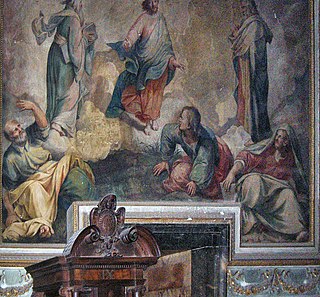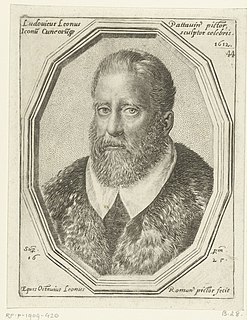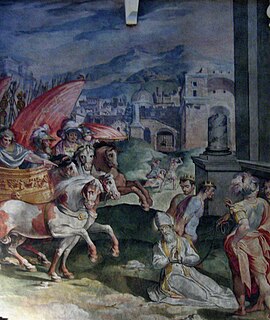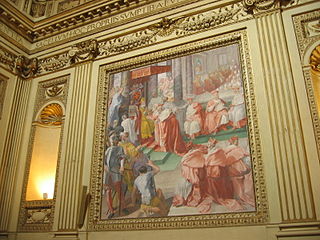Related Research Articles
Ottaviano Nonni, called Il Mascherino, was an Italian architect, sculptor, and painter born in Bologna. Apprentice of Giacomo Barozzi da Vignola, he was active in Emilia and in Rome, where he had been living in the rione of Borgo, in the road still bearing his name.

Cesare Nebbia (c.1536–c.1622) was an Italian painter from Orvieto who painted in a Mannerist style.
Giovanni Battista Viola was an Italian painter of the early Baroque period in Rome.
Paris Nogari was an Italian painter of the Renaissance period, a minor pupil of Cesare Nebbia active mainly in Rome. He painted in the library of the Vatican in a style resembling Raffaellino da Reggio and was among the painters who frescoed Santa Susanna and San Pietro in Vincoli in Rome.

Durante Alberti was an Italian painter of the late-Renaissance period.

Antonio Circignani (1560–1620) was an Italian painter of the late-Renaissance (Mannerism) period and early Baroque. Born in Pomarance, he is known also as Antonio Pomarancio. He was the son of the painter Niccolò Circignani, and with his father, who died in 1588, he worked in Rome. He was featured in the Vite published by Giovanni Baglione.
Terenzio Terenzi (1575–1621) was an Italian painter of the late-Renaissance or Mannerist period. Born near Pesaro, he is also known as Terenzio da Urbino or il Rondolino. He was a pupil of the painter Federigo Barocci. There is an altarpiece by Terenzi in the Cathedral of Sant'Andrea, a Baptism of Constantine in the quadreria di San Costanzo, and an Assumption of the Virgin (1621) in the church of the Cappuccini in Rome. According to Baglione, Terenzi visited Rome, where he was favored with the protection of Cardinal Montalto, nephew of Pope Sixtus V. Having practiced a deceptions on his benefactor by imposing on him a picture he himself painted for a work of Raphael, he was disgraced. There is a picture of his own composition in the church of San Silvestro, in Rome, representing the Virgin and Infant Christ, with several Saints.

Giovanni Battista Crescenzi (1577–1635) was an Italian painter and architect of the early-Baroque period, active in Rome and Spain, where he helped decorate the pantheon of the Spanish kings at El Escorial.
Giovanni Luigi Valesio, also known as Giovanni Valesio or Luigi Valesio, was an Italian painter and, most prominently, an engraver of the early-Baroque, active in his native city of Bologna, and then in Rome.

Onorio Longhi (1568–1619) was an Italian architect, the father of Martino Longhi the Younger and the son of Martino Longhi the Elder.

Lodovico Leoni was an Italian painter of the Renaissance period, mainly active in Rome. He was also a medallist, and coin-engraver. Other sources cite his name as Luigi Leone

Vespasiano Strada (1582–1622) was an Italian painter and engraver of the early-Baroque period, mainly active in Rome. His biography is summarized by Giovanni Baglione.
Cesare Torelli Romano was an Italian painter.
Francesco Traballesi was an Italian painter and architect. He was born in Florence in 1541, flourished in Rome during the papacy of Pope Gregory XIII (1572–1585), and died in 1588 in Mantua, where he was working as an architect for the duke Vincenzo Gonzaga. In the Roman church of Sant'Atanasio dei Greci, which was founded by Gregory, there are two altar-pieces by Traballesi, an Annunciation, and a Christ disputing with the Doctors, while in the Greek Pontifical College of Saint Athanasius, next to the church, are more of his paintings, with Apostles, Fathers of the Church, and a Crucifixion, which were once parts of the iconostasis of the church itself. In the Town Hall of Tivoli, anciently called Tibur in Latium, are two frescoes painted by Traballesi in 1574, showing scenes of The mythic foundation of Tibur. His brother Bartolommeo Traballesi was an assistant of Vasari.

Giovanni Battista Fiammeri was an Italian painter and Jesuit priest, active in Florence.
Fabrizio Parmigiano was an Italian painter of the late-Baroque period. Born at Parma, he was assisted by his wife Ippolita. He specialized in landscapes.
Leonardo da Sarzana, also called Lionardo Sarzana was an Italian sculptor of the Renaissance, active from the mid to late 16th century. His most famous sculpture is that of Pope Pius V made for the Sistine Chapel at Santa Maria Maggiore in Rome.

Marzio di Colantonio or di Colantonio Ganassini or di Cola Antonio was an Italian painter, as a painter of still-lifes and landscapes, and fresco decorations of grotteschi and battle scenes with small figures. His still-life paintings contain hunted game.

Pasquale Cati was an Italian Mannerist painter active mostly in Rome.
Antonio Scalvati (1559–1619) was an Italian painter, mainly active in Rome. He was known for his portraits.
References
- Baglione, Giovanni (1733) [1641]. Le Vite de' Pittori, Scultori, Architetti, ed Intagliatori dal Pontificato di Gregorio XII del 1572. fino a' tempi de Papa Urbano VIII. nel 1642 [Lives of the painters, sculptors, architects, and engravers during the papacies of Gregory XII in 1572 to Urban VIII in 1642]. Naples: Giovanni Battista Passari. p. 158.
Attribution:
 This article incorporates text from a publication now in the public domain : Bryan, Michael (1886). "Conti, Cesare and Vincenzio". In Graves, Robert Edmund (ed.). Bryan's Dictionary of Painters and Engravers (A–K). Vol. I (3rd ed.). London: George Bell & Sons.
This article incorporates text from a publication now in the public domain : Bryan, Michael (1886). "Conti, Cesare and Vincenzio". In Graves, Robert Edmund (ed.). Bryan's Dictionary of Painters and Engravers (A–K). Vol. I (3rd ed.). London: George Bell & Sons.